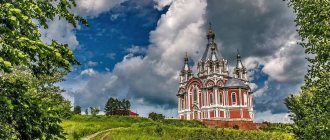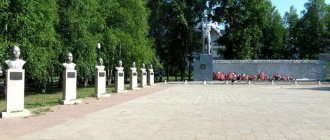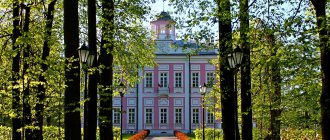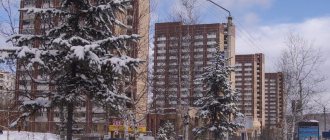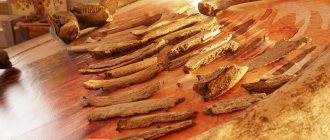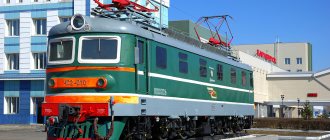Dmitriev-Lgovsky, as locals call him, never officially bore this name. According to all documents, the city of Dmitriev is located in the Kursk region on the Svapa River. It occupies a small area, only 8 km2, and less than 7 thousand people live there today. But these 7 thousand love their small and quiet town very much, take care of its past, preserve the memory of their fellow countrymen and support traditions.
Today the city is headed by a young leader. A group of enthusiasts has created an excellent website that helps local residents not only get the information they need, but also keep abreast of all city news, discuss exciting issues, and get answers to questions. Undoubtedly, such a directory is the best guide for tourists who come here. Dmitriev-Lgovsky has very active young people who do not allow their city to grow old.
From Prophetic Oleg to...
The fortress on the right bank of the Svapa was erected in the 9th century to protect the lands of the ancient Russian principality, which was under the hand of Oleg, nicknamed the Prophetic. This is where the history of the city begins.
The internecine wars of the Russian princes, the raids of the Polovtsians and other nomadic tribes wiped out the settlement from the face of the earth, and it was rebuilt again. Batu Khan, who “with fire and sword” walked through the lands of Rus', did not spare him.
Only in the 17th century did a new settlement emerge from the ruins, called Dmitrievskoye, which, by decree of Catherine the Great at the end of the 18th century, was granted the status of a city and the name Dmitriev-on-Svape (to distinguish it from Dmitrovsk in the Oryol province). Later, only Dmitriev of the Lgov district remained.
The city grew and developed. Residents received their main income from livestock farming and farming. Factories were built to process their products: oil mill, flour mill, grain crusher. At the end of the 19th century, a railway was built near the city, which, together with the waterway, gave new impetus to the growth of production and trade. A women's gymnasium was opened and a hospital was built.
Map
| Dmitriev: maps |
Dmitriev: photo from space (Google Maps) Dmitriev: photo from space (Microsoft Virtual Earth)
| Dmitriev. Nearest cities. Distances in km. on the map (in brackets along roads) + direction. Using the hyperlink in the distance , you can get the route (information courtesy of the AutoTransInfo website) | |||
| 1 | Zheleznogorsk | 31 (37) | NE |
| 2 | Konyshevka | 34 (163) | SE |
| 3 | Komarichi (Bryansk region) | 37 (82) | NW |
| 4 | Sevsk | 39 (97) | Z |
| 5 | Khomutovka | 40 (55) | SW |
| 6 | Dmitrovsk | 43 (56) | WITH |
| 7 | Lgov | 49 (143) | YU |
| 8 | Fatezh | 54 (95) | IN |
| 9 | Lokot (Bryansk region) | 60 (122) | NW |
| 10 | Trosna (Oryol region) | 60 (71) | NE |
| 11 | them. Karl Liebknecht | 62 () | SE |
| 12 | Kurchatov | 64 (174) | SE |
| 13 | Rylsk | 66 (101) | SW |
| 14 | Suzemka (Bryansk region) | 71 (132) | Z |
| 15 | Soskovo (Oryol region) | 73 (189) | WITH |
| 16 | Korenevo | 78 (127) | YU |
| 17 | Kromy (Oryol region) | 78 (91) | NE |
| 18 | Pryamitsyno | 79 (168) | SE |
| 19 | Shablykino (Oryol region) | 82 (202) | WITH |
| 20 | Ponyri | 86 (133) | IN |
| 21 | Navlya (Bryansk region) | 87 (159) | NW |
| 22 | Kursk | 88 (145) | SE |
| 23 | Zolotukhino | 90 (142) | IN |
| 24 | Glushkovo | 92 (130) | YU |
| 25 | Bolshoye Soldatskoye | 92 (188) | YU |
| 26 | Glazunovka (Oryol region) | 95 (195) | NE |
| 27 | Suja | 102 (161) | YU |
| 28 | Maloarkhangelsk | 102 (210) | IN |
| 29 | Trubchevsk | 102 (306) | NW |
| 30 | Naryshkino (Oryol region) | 104 (156) | NE |
a brief description of
Located on the southwestern edge of the Central Russian Upland, on the river. Svapa (Dnieper basin), 120 km northwest of Kursk. Railway station.
Territory (sq. km): 8
Information about the city of Dmitriev on the Russian Wikipedia site
Historical sketch
An ancient village on the river. Svapa (the right tributary of the Seim), known as Svapsk, eventually received the name Dmitrievskoye (after the church in the name of Demetrius of Thessaloniki).
In 1779, the village of Dmitrievskoye was transformed into the district town of Dmitriev of the Kursk governorate (since 1796 - Kursk province). To distinguish it from the cities of Dmitrov (Moscow province) and Dmitrovsk (Oryol province), an indication of its location was included in the name Dmitriev in 1784 and it became Dmitriev-on-Svape. This name was also used in the unofficial form Dmitrosvapsk and the colloquial, reinterpreted Dmitroslavsk, Dmitroslavl, Mitroslav.
In the vaults of 1859, 1898. city of Dmitriev. Official documents of the 1930s mention Dmitriev. In 1929, Dmitriev was called Dmitriev-Lgovsky, since at that time the city belonged to the Lgov district (before that - in the Lgov district). There is no information about the official date for renaming the city. [According to the 1939 population census, it is listed as Dmitriev-Lgovsky, the center of the Dmitrievsky district].
In 1856, in the district town of Dmitriev, Kursk province, there were 2 churches, 287 houses, 38 shops.
During the Great Patriotic War of 1941-45, the city was occupied by Nazi troops on October 8, 1941. It was liberated on March 2, 1943 by troops of the Central Front during an operation in the Sevsk direction.
Economy
Food industry enterprises: canning factories, butter factories, meat factories.
, hemp, obozotstroitelny.
Main enterprises
PRODUCTION OF CANNED FRUITS AND VEGETABLES
OJSC "Agro-industrial corporation 'Dmitrievkonservy'"
307500, Kursk region, Dmitrievsky district, Dmitriev, st.
Promyshlennaya, 1 Offers:
canned fruits and vegetables, meat, tomatoes, juices, baked goods
Culture, science, education
Museum of Local Lore.
Writer Yu.P. studied in Dmitriev-Lgovsky. Hermann.
Museums, galleries, exhibition halls
Dmitrievsky State Local Lore Museum named after. A.F. Vangengeyma 307500, Kursk region, Dmitrievsky district, Dmitriev, st. Lenina, 47 Phone(s): (47150) 2-1448 Website: https://kursk-museum.ru/
Architecture, sights
Memorial with an eternal flame in memory of those killed in the Great Patriotic War of 1941-45.
| Population by year (thousands of inhabitants) | |||||||
| 1856 | 2.8 | 1979 | 10.5 | 2005 | 8.3 | 2014 | 7.1 |
| 1897 | 6.1 | 1989 | 11.2 | 2006 | 8.1 | 2015 | 6.8 |
| 1913 | 6.9 | 1992 | 11.2 | 2007 | 8.0 | 2016 | 6.8 |
| 1926 | 4.7 | 1996 | 11.0 | 2008 | 7.9 | 2017 | 6.6 |
| 1931 | 5.7 | 1998 | 10.9 | 2010 | 7.6 | 2018 | 6.4 |
| 1939 | 7.5 | 2000 | 10.6 | 2011 | 7.7 | 2019 | 6.4 |
| 1959 | 8.4 | 2001 | 10.3 | 2012 | 7.4 | 2020 | 6.3 |
| 1970 | 9.5 | 2003 | 8.8 | 2013 | 7.2 | 2021 | 6.2 |
Soviet authority
If there were factories in the city, then there was a proletariat. The revolutionary movement of 1905, which shook Russia, did not pass by Dmitriev-Lgovsky. The peasants destroyed the manor's estates, took away grain, and cut down forests. The uprising was crushed by the troops that entered.
In December 1917, Soviet power came. In the first Soviet years, public life revived. Gradually, everything returned to normal: enterprises worked, grain was sown, five-year plans were fulfilled and exceeded. There were two cinemas, several schools, and a pedagogical college in the city.
War
The Germans entered the city of Dmitriev-Lgovsky, Kursk region, on October 8, 1941. The destruction of people and their homes began. Everyone was taken to be executed; neither the old nor the young were spared.
Just four days after the start of the occupation, the Dmitrievsky detachment began to fight the invaders, turning the city into the center of the partisan movement in the Kursk region. Gaining experience, the partisans made increasingly daring forays, destroying the fascists in their rear, diverting enemy forces and equipment from the front. The population of the occupied areas helped the partisans, their fathers and grandfathers, husbands and brothers in every possible way. The city was liberated in March 1943.
Many residents of the small town went to the front in the first days of the war and defended their country there. Fifteen Dmitrievites became Heroes of the Soviet Union, two became full holders of the Order of Glory.
Notes[ | ]
- ↑ 1 2 3
The size of the rural population and its distribution in the Moscow region (results of the 2010 All-Russian Population Census).
Volume III (undefined)
(DOC+RAR). M.: Territorial body of the Federal State Statistics Service for the Moscow Region (2013). Retrieved October 20, 2013. Archived October 20, 2013. - Postal codes Klinsky district
- Alphabetical list of settlements of municipal districts of the Moscow region (unspecified)
(RTF+ZIP). Development of local self-government in the Moscow region. Access date: February 4, 2013. Archived January 11, 2012. - Law of the Moscow Region dated March 25, 2011 No. 36/2011-OZ “On amendments to the Law of the Moscow Region “On the status and boundaries of the Klin municipal district and newly formed municipalities within it”, Law of the Moscow Region “On the status and boundaries of the Solnechnogorsk municipal district” and newly formed municipalities within it,” Law of the Moscow Region “On the status and boundaries of the Istrinsky municipal district and newly formed municipalities within it”” (adopted by resolution of the Moscow Regional Duma of March 17, 2011 No. 8/149-P)
- named after Dmitriev. Photo Planet
- Village named after Dmitriev (Russian). Website "Heroes of the Country".
- Koryakov Yu. B.
Ethno-linguistic composition of settlements in Russia: [arch. November 17, 2020]: database. — 2016. - Alphabetical list of settlements in municipal districts of the Moscow region as of January 1, 2006 (unspecified)
(RTF+ZIP). Development of local self-government in the Moscow region. Access date: February 4, 2013. Archived January 11, 2012.
Modern city of Dmitriev-Lgovsky
After the war, the destroyed city was completely restored, or rather rebuilt. In a modern, but still small and calm town, there are several enterprises, including Dmitrievkonservy, a hospital, a House of Culture, an agricultural college, schools, and kindergartens. It publishes its own newspaper, Dmitrievsky Vestnik.
Tourists have a lot to see. There are several monuments to front heroes in the city. Of course, there are monuments to the partisans, and the Church of Demetrius of Thessalonica, after whom the city was named, and the A. F. Vangenheim Museum of Local Lore.
The famous fellow countryman of the Dmitrievites - A. F. Vangengeym
Anatoly Feodosievich lived from 1881 to 1937. He is known to us as the person who organized and headed the USSR Weather Bureau, which today is called Roshydromet. Soon after his birth, his father, Feodosius Petrovich, a national teacher and famous meteorologist, moved the family to an estate located in the Dmitrievsky district of the Kursk province. There he equipped a weather station, where, together with his grown-up son, he conducted observations and conducted experiments.
Anatoly, after graduating from high school, entered Moscow University, where he joined the Bolshevik Party. For participating in student unrest, he was expelled and imprisoned for six months, and then sent into exile to his father’s estate. Later he will complete his studies at both the university and the agricultural institute.
He immediately accepted the revolution of 1917 with all his heart and was appointed inspector of public education in Dmitriev-Lgovsky.
Two years later, a museum of “homeland studies”, organized by him, opened there, which operates and bears his name to this day.
In 1922, returning to his main activity, he moved to Petrograd, where he held high leadership positions. In 1934 he was arrested as an “enemy of the people” and sent to Solovki. In 1937, he was shot and buried in a mass grave at the Sandarmokh cemetery near Medvezhyegorsk.
Dmitriev-Lgovsky, Kursk region of Russia, preserves the memory of his fellow countryman by giving his name to the local history museum he founded.
Data on the population and economy of the city in the 19th century
According to the “Geographical Dictionary of the Russian State”, published in 1804, in the city of Dmitriev there were the following number of inhabitants and buildings: “clergy and clergy - 8, merchants - 16, burghers - 2, Little Russians - 5, economic peasants - 169, total of different ranks up to 200 people. Buildings in the city: a stone church - 1, and all others are wooden, various government connections - 7, private noble yards - 2, sacred and ecclesiastical houses - 3, all others - 39, total - 44; herbergs - 2, drinking houses - 2, tavern - 1, smithy - 1. The length and width of it is no more than a mile, the circumference is in proportion to that. Merchants and townspeople sell on Thursdays only small medicines for village residents: oak, pine and aspen forests are brought to the Oryol province from the city of Karachev. Annual fairs are held around it in the settlement of Mikhailovka, the villages of Bereza and Petrovsky. The Svapa River flowing in the city is up to 10 fathoms wide and up to 3 fathoms deep. The fish caught in it are bream, roach, perch, catfish and pike, of which the best are bream and pike. The water in it is mediocre... The mountain on which the city stands is extremely high, but there are no large ones in the area. In addition to the usual animals there, there are beavers, otters and moose. There are ridges of black land, grain is sown of all kinds and comes in average proportions, rye and buckwheat - 7, oats - 9, barley, wheat and hemp - 5, peas - 6 times, flax - one and a half times, millet - 18, and poppy - 30 times . Ground apples and pears are planted a lot in this district and are harvested with the greatest profit. Because of their surplus, this bread is transported to other cities, most notably to Sevsk. In the entire district there are settlements of state, noble and single-yard people: villages - 57, selets - 35, settlements - 3, settlements - 2, villages - 43, farmsteads - 5, in total - 145; In these, all males in the 4th revision have 26,617 souls. Churches near villages and settlements consist of stone - 8, wooden - 57, rope factories - 3, spinning - 10, distillery - 1, rope - 1, wax - 2, leather - 2, dyeing - 1, leather - 1, brick - 4, lime - 2, oil - 2, shops in trading villages - 81, almshouses - 3, taverns - 4, drinking houses - 14, forges - 48, water mills - 97, windmills - 2. Large rivers - Svapa, mediocre - Usozh, small rivers - 48. Nobles living in this district - 176, having only possessions and not living - 52, their houses are stone - 4, wooden - 210.”
Map of 1821. The northwestern part of the Kursk province with Dmitrievsky district
In 1861, in Dmitriev there were 2236 souls of both sexes (1127 males), of which 366 were merchants of both sexes, 904 bourgeois. There were 1 churches in the city, 1 schismatic chapel. 381 houses (3 stone), 38 shops, a school. City land 261 dessiatinas. In 1860 there were 3 factories: lard, grain, brick. All factories produced products worth 19,743 rubles. In the city during this period there were 2 weekly bazaars and 3 fairs a year; in 1861, goods worth 17,000 rubles were brought to them and sold for 9,200 rubles. Merchants from Kursk came to the fairs with soap and “red” goods, from Sevsk with leather, candles and soap, Dmitrov and Oryol merchants bought hemp seed, honey, wax and hemp in Dmitriev, and Fatezh merchants bought livestock.
In 1870, the number of inhabitants in the city was 3004, and in 1890 - 4445 people. In 1890, in Dmitriev there were: a flour mill with an annual turnover of 17,000 rubles, a grain crushing plant with a turnover of 5,350 rubles, two oil mills with an annual turnover of 49,750 rubles. City revenues in 1890 were 12,618 rubles, expenses - 12,882 rubles... Land - 261 dessiatines... Residential buildings 473, stone - 6... There was a women's gymnasium and a city school.
According to the 1897 census, the city had 7,300 inhabitants. In the early 90s of the last century, a project was developed to build a railway from Rylsk to Bryansk. According to this project, the railway was supposed to pass 40 km west of the city of Dmitriev. But then the project was changed, and in 1898 the railway passed in close proximity to the city.
Dmitriev railway station, late 19th century.
The presence of good transport connections contributed to the development of the city.
